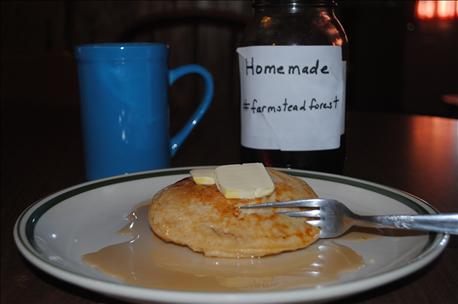
If you live in the northern Plains today, the current blizzard conditions may push us to long for Spring. For northern forest states, tapping maple trees in late winter is part of a traditional transition of seasons. Folks in Canada or in states like Vermont, New York and Maine know all about tapping maples in late February and early March for sap to make maple syrup. They live in the highest production areas. But, does anyone on the prairie know about producing maple syrup? As it turns out, they do.

THE GOOD STUFF: Whether you live in the woods or on the prairie, your farmstead maple trees can produce delicious home-collected maple syrup.
My grandparents tapped maples for sap which they boiled down for maple sugar candy. Most maple syrup is produced from sugar and red maples, but common prairie trees like silver maple and boxelder – also in the Acer genus - make good syrup. Just ask South Dakota State University forestry and horticulture professor, Peter Schaefer.
Sap flow in maple trees requires day temperatures above freezing and night temperatures below freezing. “While we generally get these conditions most springs, it does not always occur or is highly variable during the season, so sap production will follow suit,” Schaefer says. “In terms of getting started, shooting for one to three gallons of syrup would be good. That means you will be collecting between 40 and 120 gallons of sap,” he says. “That amount of sap is equal to about four to 12 taps, as one might expect 10 gallons or so of sap per tap during the season.”
Related: Farming is like basketball
To be tapped for sap, trees need to be at least 12 inches in diameter. Trees 16 inches in diameter and more can support two taps. All you need to tap the tree is a cordless drill and either a 5/16 or 7/16 bit, depending on the size of the tap or spile you have purchased or made for the process. “I use a doweling bit because of the very clean hole it drills. The hole should be drilled about one and a half inches into the tree at a slightly upward angle,” Schaefer says. “The spile is then tapped into the tree until it is seated, so you want to tap it in to just beyond when it gets tight.” If you tap it in too far, it will crack the wood, resulting in sap flow around the tap and not into the collection container.
Schaefer uses plastic two gallon buckets for collecting the sap. “Anything that will collect water and is sanitary will do,” he says. “For getting started, use what you have on hand, while keeping in mind that buying the actual tapping equipment will not be a major expense on a small scale.”
Sap does not store very well, even when refrigerated. “You really can’t store sap for more than a few days unless you freeze it, so as soon as you have enough to start boiling down, that is the time to do it,” Schaefer says. “I would suggest in the 20 to 40 gallons of sap range.” Boiling sap down to syrup is an outdoor activity that requires time and patience. “For most purposes, we can accept 219 degrees as the finishing temperature for the syrup,” he says. The syrup is poured in canning jars hot, lids are put on and jars are turned upside down for a minute to sterilize the lids.
For more information you can contact Schaefer at 605-688-4732 or visit iGrow online resources at igrow.org/gardens/gardening/harvesting-maple-syrup-in-south-dakota/.
About the Author(s)
You May Also Like






